Energy Storage Science and Technology ›› 2024, Vol. 13 ›› Issue (2): 546-567.doi: 10.19799/j.cnki.2095-4239.2023.0577
• Energy Storage System and Engineering • Previous Articles Next Articles
Xiaolei LI1( ), Jian GAO2(
), Jian GAO2( ), Weidong ZHOU1,2(
), Weidong ZHOU1,2( ), Hong LI3,4(
), Hong LI3,4( )
)
Received:2023-08-28
Revised:2023-09-14
Online:2024-02-28
Published:2024-03-01
Contact:
Jian GAO, Weidong ZHOU, Hong LI
E-mail:lixiaolei@buct.edu.cn;gaojian@buct.edu.cn;zhouwd@buct.edu.cn;hli@mail.iphy.ac.cn
CLC Number:
Xiaolei LI, Jian GAO, Weidong ZHOU, Hong LI. Application of COMSOL multiphysics in lithium-ion batteries[J]. Energy Storage Science and Technology, 2024, 13(2): 546-567.
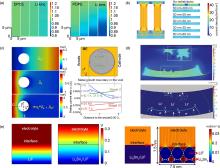
Fig. 2
(a) In double polymer electrolyte and organic-inorganic composite double polymer electrolyte, the concentration distribution of lithium ion evolves with time [14]; (b) The current density distribution of porous electrolyte membrane with multilayer nano sheet interface phase [15]; (c) The potential distribution at the electrolyte cavity, the metal boundaries within the cavity at different deposition times, and the deposition current [19]; (d) The von Mises Plane stress analysis, and the corresponding electric potential field and the ion flux density in the Solid-state cell [21]; (e) Potential distribution and lithium flux distribution in the electrolyte/solid electrolyte interface/lithium negative electrode system when there is no/no mixed conductive interface phase Li5Sn2 [22]"


Fig. 3
(a) Li+ transport path and simulation of Li+ concentration distribution in thick electrode [33]; (b) Lithium concentration distribution of three carbon binder domain states at different discharge capacities [36]; (c) Lithium ion concentration distributions of solid electrolyte (up) and CEI (down) in contact with cathode NCM under [37]; (d) Distribution of lithium ion concentration, volume strain, and von Mises stress in positive electrode particles during charge-discharge cycling [38]; (e) The reaction degrees of positive-solvent reaction for various cathode materials (left); Heat generation rates due to different exothermic reactions for the LiMn2O4 cell during 255 ℃ and 275 ℃ (middle), and for LiFePO4 during 275 ℃ (right) [45]"
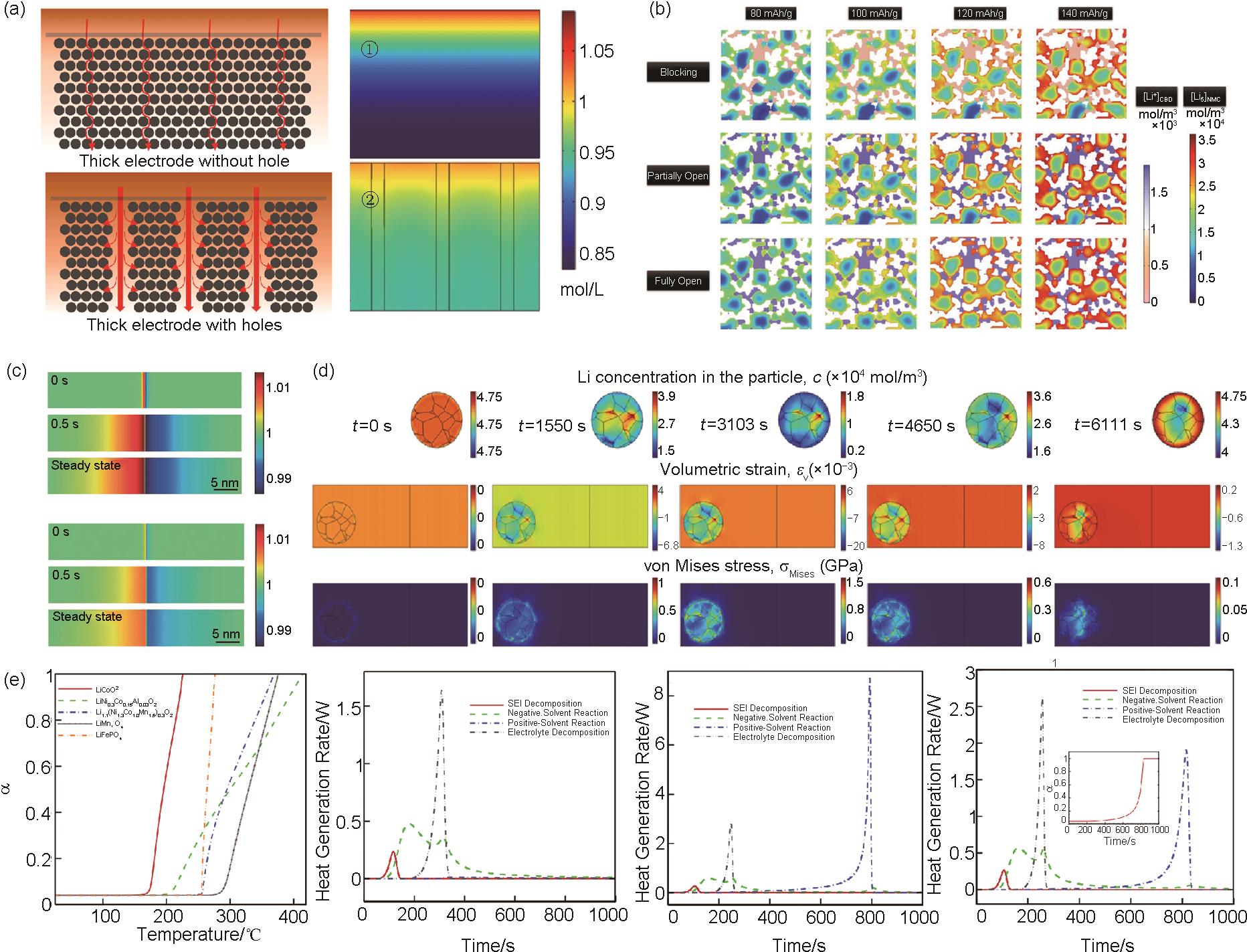

Fig. 4
(a) The size dependence of the fracture of silicon nanoparticles during the lithiation process (above); When the particle size D of silicon nanoparticles under the critical Dc ≈150 nm, silicon nanoparticles will not crack or fracture upon first lithiation; while D increases, the ratio of surface thickness to particle size (t/D) decreases, indicating the advancing entrance into the first fracture (middle); Stress relaxation due to surface cracking with the cross section of radii R0 and R0/2, respectively; the crack lengths are 0.1R0 in both cases (below, Red represents full lithiation, and blue represents unlithiated)[47]; (b) The lithiation states (left) and the corresponding maximum in-plane principal stress in the cross sections (right) of〈100〉and〈112〉at various lithiation snapshots[48]; (c) For hierarchical porous Si nanoparticles, volume changes during lithiation and delithiation are mainly accommodated by inward Li breathing, causing negligible exterior volume change[49](Red: fully lithiated, blue: unlithiated)"

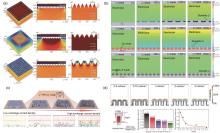
Fig. 5
(a) Current density distributions on lithium metal surfaces with different heights (h), widths (w) and ridge lengths (LR)[53]; (b) The morphology evolution of BLi, RGLi and FGLi electrodes [58]; (c) Morphology and uniformity of lithium deposition at different applied current densities [62]; (d) Schematic of lithium deposition behavior at different exchange current densities (top) and simulated deposition cross-section (bottom) [64]"

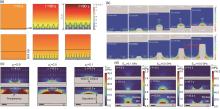
Fig. 6
(a) Lithium deposition morphology with different SEI coverage [66]; (b) Lithium deposition morphology on LiRAP- ASEI/Cu (top) and Cu foil (bottom) [67]; (c) Von Mises stress distribution and failure time of SEI interfacial films with different pd; (d) Von Mises stress distribution and failure time of SEI interfacial films with different ESEI[69]"


Fig. 11
The analysis of publications in the field of COMSOL Multiphysics using the Science Citation Index (SCI), including (a) the annual trend of SCI publications; (b) density maps of SCI publications from major research countries; (c) keyword and contribution networks; and (d) the keyword and contribution networks related to lithium-ion batteries"
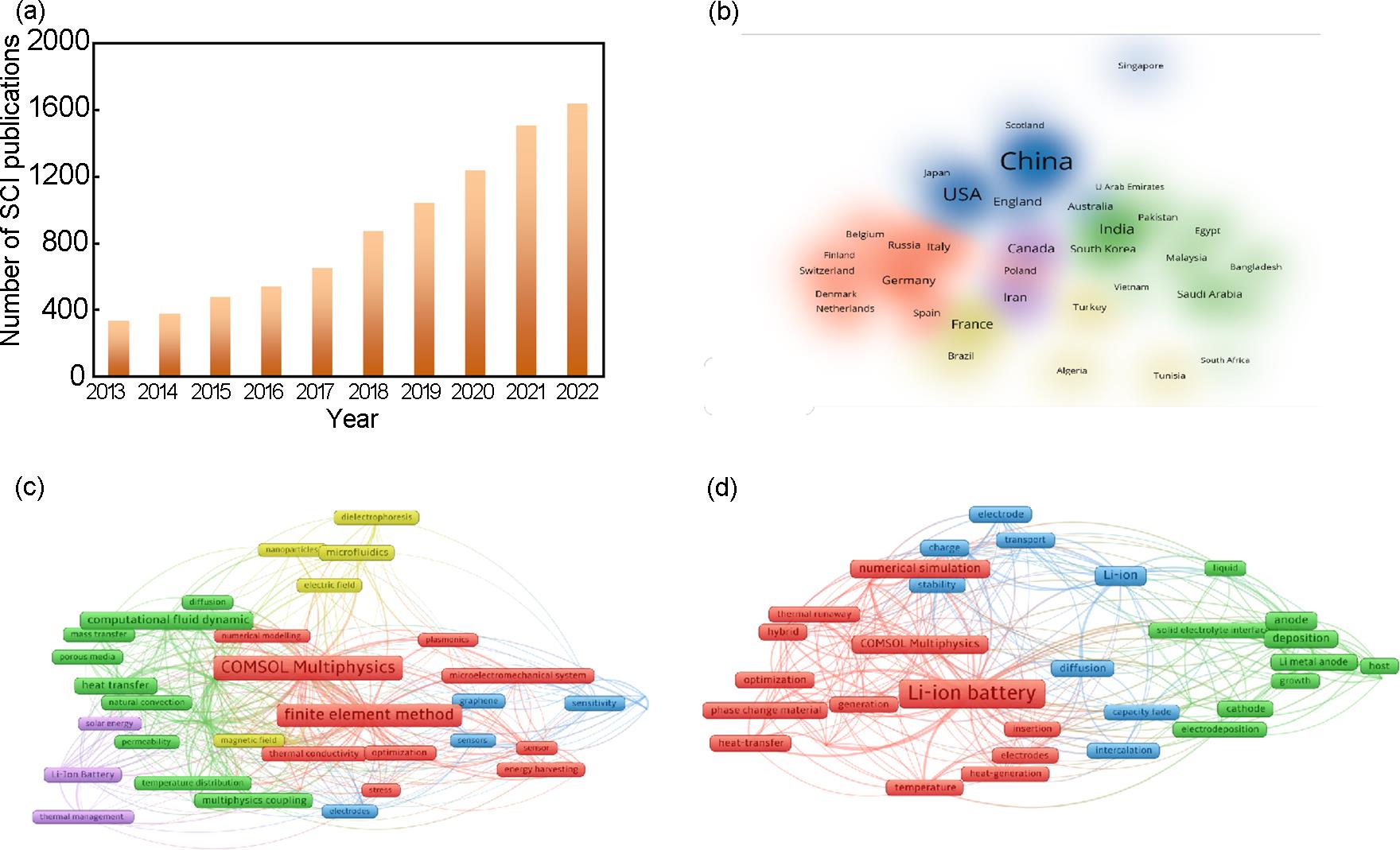
| 1 | FEYNMAN R P, LEIGHTON R B, SANDS M, et al. The Feynman lectures on physics; vol. I[J]. American Journal of Physics, 1965, 33(9): 750-752. |
| 2 | DESHPANDE V S, MCMEEKING R M. Models for the interplay of mechanics, electrochemistry, thermodynamics, and kinetics in lithium-ion batteries[J]. Applied Mechanics Reviews, 2023, 75(1): 010801. |
| 3 | FRANCO A A. Multiscale modelling and numerical simulation of rechargeable lithium ion batteries: Concepts, methods and challenges[J]. RSC Advances, 2013, 3(32): 13027-13058. |
| 4 | FRANCO A A, RUCCI A, BRANDELL D, et al. Boosting rechargeable batteries R&D by multiscale modeling: Myth or reality?[J]. Chemical Reviews, 2019, 119(7): 4569-4627. |
| 5 | DICKINSON E J F, EKSTRÖM H, FONTES E. COMSOL Multiphysics®: Finite element software for electrochemical analysis. A mini-review[J]. Electrochemistry Communications, 2014, 40: 71-74. |
| 6 | ZHAO Y, STEIN P, BAI Y, et al. A review on modeling of electro-chemo-mechanics in lithium-ion batteries[J]. Journal of Power Sources, 2019, 413: 259-283. |
| 7 | XUE R X, LI X, ZHAO H L, et al. Phase field model coupling with strain gradient plasticity for fracture in lithium-ion battery electrodes[J]. Engineering Fracture Mechanics, 2022, 269: 108518. |
| 8 | 王刚, 安琳. COMSOL Multiphysics工程实践与理论仿真: 多物理场数值分析技术[M]. 北京: 电子工业出版社, 2012. |
| WANG G, AN L. COMSOL multiphysics engineering practice and theoretical simulation: Multi-physical field numerical analysis technology[M]. Beijing: Publishing House of Electronics Industry, 2012. | |
| 9 | LUO P F, LI P C, MA D Z, et al. Coupled electrochemical-thermal-mechanical modeling and simulation of lithium-ion batteries[J]. Journal of the Electrochemical Society, 2022, 169(10): 100535. |
| 10 | LUO P F, LI P C, MA D Z, et al. A novel capacity fade model of lithium-ion cells considering the influence of stress[J]. Journal of the Electrochemical Society, 2021, 168(9): 090537. |
| 11 | DICKINSON E J F, LIMON-PETERSEN J G, COMPTON R G. The electroneutrality approximation in electrochemistry[J]. Journal of Solid State Electrochemistry, 2011, 15(7): 1335-1345. |
| 12 | LIU W, LEE S W, LIN D C, et al. Enhancing ionic conductivity in composite polymer electrolytes with well-aligned ceramic nanowires[J]. Nature Energy, 2017, 2(5): 17035. |
| 13 | LIU K W, JIANG S S, DZWINIEL T L, et al. Molecular design of a highly stable single-ion conducting polymer gel electrolyte[J]. ACS Applied Materials & Interfaces, 2020, 12(26): 29162-29172. |
| 14 | LIANG J Y, ZENG X X, ZHANG X D, et al. Engineering Janus interfaces of ceramic electrolyte via distinct functional polymers for stable high-voltage Li-metal batteries[J]. Journal of the American Chemical Society, 2019, 141(23): 9165-9169. |
| 15 | ZHOU Y G, ZHANG X, DING Y, et al. Redistributing Li-ion flux by parallelly aligned holey nanosheets for dendrite-free Li metal anodes[J]. Advanced Materials, 2020, 32(38): e2003920. |
| 16 | JAUMAUX P, LIU Q, ZHOU D, et al. Deep-eutectic-solvent-based self-healing polymer electrolyte for safe and long-life lithium-metal batteries[J]. Angewandte Chemie (International Ed in English), 2020, 59(23): 9134-9142. |
| 17 | XIONG P, ZHANG F, ZHANG X Y, et al. Atomic-scale regulation of anionic and cationic migration in alkali metal batteries[J]. Nature Communications, 2021, 12: 4184. |
| 18 | LIU Y Y, XU X Y, JIAO X X, et al. Role of interfacial defects on electro-chemo-mechanical failure of solid-state electrolyte[J]. Advanced Materials, 2023, 35(24): 2301152. |
| 19 | XIONG S Z, XU X Y, JIAO X X, et al. Mechanical failure of solid-state electrolyte rooted in synergy of interfacial and internal defects[J]. Advanced Energy Materials, 2023, 13(14): 2203614. |
| 20 | TU Q S, SHI T, CHAKRAVARTHY S, et al. Understanding metal propagation in solid electrolytes due to mixed ionic-electronic conduction[J]. Matter, 2021, 4(10): 3248-3268. |
| 21 | SUN F, WANG C, OSENBERG M, et al. Clarifying the electro-chemo-mechanical coupling in Li10SnP2S12 based all-solid-state batteries[J]. Advanced Energy Materials, 2022, 12(13): 2103714. |
| 22 | LI W, GAO J, TIAN H Y, et al. SnF2-catalyzed formation of polymerized dioxolane as solid electrolyte and its thermal decomposition behavior[J]. Angewandte Chemie, 2022, 134(6): e202114805. |
| 23 | HU A J, CHEN W, DU X C, et al. An artificial hybrid interphase for an ultrahigh-rate and practical lithium metal anode[J]. Energy & Environmental Science, 2021, 14(7): 4115-4124. |
| 24 | SUN J Q, HE C H, YAO X M, et al. Hierarchical composite-solid-electrolyte with high electrochemical stability and interfacial regulation for boosting ultra-stable lithium batteries[J]. Advanced Functional Materials, 2021, 31(1): 2006381. |
| 25 | KIM S, YOON G, JUNG S K, et al. High-power hybrid solid-state lithium-metal batteries enabled by preferred directional lithium growth mechanism[J]. ACS Energy Letters, 2023, 8(1): 9-20. |
| 26 | CHEN W, HU Y, LV W Q, et al. Lithiophilic montmorillonite serves as lithium ion reservoir to facilitate uniform lithium deposition[J]. Nature Communications, 2019, 10: 4973. |
| 27 | YAN M, LIANG J Y, ZUO T T, et al. Stabilizing polymer-lithium interface in a rechargeable solid battery[J]. Advanced Functional Materials, 2020, 30(6): 1908047. |
| 28 | DOYLE M, FULLER T F, NEWMAN J. The importance of the lithium ion transference number in lithium/polymer cells[J]. Electrochimica Acta, 1994, 39(13): 2073-2081. |
| 29 | ROZENBLIT A, TORRES W R, TESIO A Y, et al. Effect of particle size in Li4Ti5O12 (LTO)-LiMn2O4 (LMO) batteries: A numerical simulation study[J]. Journal of Solid State Electrochemistry, 2021, 25(8): 2395-2408. |
| 30 | ANSAH S, HYUN H, SHIN N, et al. A modeling approach to study the performance of Ni-rich layered oxide cathode for lithium-ion battery[J]. Computational Materials Science, 2021, 196: 110559. |
| 31 | APPIAH W A, PARK J, VAN KHUE L, et al. Comparative study on experiments and simulation of blended cathode active materials for lithium ion batteries[J]. Electrochimica Acta, 2016, 187: 422-432. |
| 32 | SUN G Y, LAI S B, KONG X B, et al. Synergistic effect between LiNi0.5Co0.2Mn0.3O2 and LiFe0.15Mn0.85PO4/C on rate and thermal performance for lithium ion batteries[J]. ACS Applied Materials & Interfaces, 2018, 10(19): 16458-16466. |
| 33 | GUO Y T, LI X H, GUO H J, et al. Visualization of concentration polarization in thick electrodes[J]. Energy Storage Materials, 2022, 51: 476-485. |
| 34 | NGANDJONG A C, RUCCI A, MAIZA M, et al. Multiscale simulation platform linking lithium ion battery electrode fabrication process with performance at the cell level[J]. The Journal of Physical Chemistry Letters, 2017, 8(23): 5966-5972. |
| 35 | CHOUCHANE M, RUCCI A, FRANCO A A. A versatile and efficient voxelization-based meshing algorithm of multiple phases[J]. ACS Omega, 2019, 4(6): 11141-11144. |
| 36 | CHOUCHANE M, RUCCI A, LOMBARDO T, et al. Lithium ion battery electrodes predicted from manufacturing simulations: Assessing the impact of the carbon-binder spatial location on the electrochemical performance[J]. Journal of Power Sources, 2019, 444: 227285. |
| 37 | VANIMISETTI S K, RAMAKRISHNAN N. Effect of the electrode particle shape in Li-ion battery on the mechanical degradation during charge-discharge cycling[J]. Proceedings of the Institution of Mechanical Engineers, Part C: Journal of Mechanical Engineering Science, 2012, 226(9): 2192-2213. |
| 38 | LIANG J Y, ZHANG X D, ZENG X X, et al. Enabling a durable electrochemical interface via an artificial amorphous cathode electrolyte interphase for hybrid solid/liquid lithium-metal batteries[J]. Angewandte Chemie (International Ed in English), 2020, 59(16): 6585-6589. |
| 39 | YUAN C H, LU W Q, XU J. Electrochemical-mechanical coupling failure mechanism of composite cathode in all-solid-state batteries[J]. Energy Storage Materials, 2023, 60: 102834. |
| 40 | LOU S F, LIU Q W, ZHANG F, et al. Insights into interfacial effect and local lithium-ion transport in polycrystalline cathodes of solid-state batteries[J]. Nature Communications, 2020, 11: 5700. |
| 41 | XU R, ZHAO K J. Corrosive fracture of electrodes in Li-ion batteries[J]. Journal of the Mechanics and Physics of Solids, 2018, 121: 258-280. |
| 42 | SUN J, LI J G, ZHOU T, et al. Toxicity, a serious concern of thermal runaway from commercial Li-ion battery[J]. Nano Energy, 2016, 27: 313-319. |
| 43 | ZHOU T, SUN J, LI J G, et al. Toxicity, emissions and structural damage from lithium-ion battery thermal runaway[J]. Batteries, 2023, 9(6): 308. |
| 44 | CAI L, WHITE R E. Mathematical modeling of a lithium ion battery with thermal effects in COMSOL Inc. Multiphysics (MP) software[J]. Journal of Power Sources, 2011, 196(14): 5985-5989. |
| 45 | PENG P, JIANG F M. Thermal safety of lithium-ion batteries with various cathode materials: A numerical study[J]. International Journal of Heat and Mass Transfer, 2016, 103: 1008-1016. |
| 46 | ZHANG S L. Chemomechanical modeling of lithiation-induced failure in high-volume-change electrode materials for lithium ion batteries[J]. NPJ Computational Materials, 2017, 3: 7. |
| 47 | LIU X H, ZHONG L, HUANG S, et al. Size-dependent fracture of silicon nanoparticles during lithiation[J]. ACS Nano, 2012, 6(2): 1522-1531. |
| 48 | YANG H, HUANG S, HUANG X, et al. Orientation-dependent interfacial mobility governs the anisotropic swelling in lithiated silicon nanowires[J]. Nano Letters, 2012, 12(4): 1953-1958. |
| 49 | XIAO Q F, GU M, YANG H, et al. Inward lithium-ion breathing of hierarchically porous silicon anodes[J]. Nature Communications, 2015, 6: 8844. |
| 50 | LEE Y G, FUJIKI S, JUNG C, et al. High-energy long-cycling all-solid-state lithium metal batteries enabled by silver–carbon composite anodes[J]. Nature Energy, 2020, 5: 299-308. |
| 51 | KIM J S, YOON G, KIM S, et al. Surface engineering of inorganic solid-state electrolytes via interlayers strategy for developing long-cycling quasi-all-solid-state lithium batteries[J]. Nature Communications, 2023, 14: 782. |
| 52 | NING Z Y, LI G C, MELVIN D L R, et al. Dendrite initiation and propagation in lithium metal solid-state batteries[J]. Nature, 2023, 618: 287-293. |
| 53 | PARK J, JEONG J, LEE Y J, et al. Micro-patterned lithium metal anodes with suppressed dendrite formation for post lithium-ion batteries[J]. Advanced Materials Interfaces, 2016, 3(11): 1600140. |
| 54 | GU J N, CHEN H, SHI Y, et al. Eliminating lightning-rod effect of lithium anodes via sine-wave analogous MXene layers[J]. Advanced Energy Materials, 2022, 12(36): 2201181. |
| 55 | 李亚捷, 陈斌, 王依平, 等. 定制电解液或隔膜实现锂离子各向异性输运从而抑制枝晶生长: 相场模拟研究[J]. 物理化学学报, 2023, 40: 2305053. |
| LI Y, CHEN B, WANG Y, et al. Inhibiting dendrite growth by customizing electrolyte or separator to achieve anisotropic lithium-ion transport: A phase-field study[J]. Acta Physico-Chimica Sinica, 2023, 40: 2305053. | |
| 56 | YANG Y F, CHEN H, WAN J Y, et al. An interdigitated Li-solid polymer electrolyte framework for interfacial stable all-solid-state batteries[J]. Advanced Energy Materials, 2022, 12(39): 2201160. |
| 57 | WANG S H, YIN Y X, ZUO T T, et al. Stable Li metal anodes via regulating lithium plating/stripping in vertically aligned microchannels[J]. Advanced Materials, 2017, 29(40): 1703729. |
| 58 | XU P, HU X Y, LIU X Y, et al. A lithium-metal anode with ultra-high areal capacity (50 mAh cm-2) by gridding lithium plating/stripping[J]. Energy Storage Materials, 2021, 38: 190-199. |
| 59 | HONG S H, JUNG D H, KIM J H, et al. Electrical conductivity gradient based on heterofibrous scaffolds for stable lithium-metal batteries[J]. Advanced Functional Materials, 2020, 30(14): 1908868. |
| 60 | ZHANG R, SHEN X, CHENG X B, et al. The dendrite growth in 3D structured lithium metal anodes: Electron or ion transfer limitation?[J]. Energy Storage Materials, 2019, 23: 556-565. |
| 61 | SAND H J S. III. On the concentration at the electrodes in a solution, with special reference to the liberation of hydrogen by electrolysis of a mixture of copper sulphate and sulphuric acid[J]. The London, Edinburgh, and Dublin Philosophical Magazine and Journal of Science, 1901, 1(1): 45-79. |
| 62 | XU X Y, JIAO X X, KAPITANOVA O O, et al. Diffusion limited current density: A watershed in electrodeposition of lithium metal anode[J]. Advanced Energy Materials, 2022, 12(19): 2200244. |
| 63 | PAREJIYA A, AMIN R, ESSEHLI R, et al. Electrochemical healing of dendrites in garnet-based solid electrolytes[J]. ACS Energy Letters, 2020, 5(11): 3368-3373. |
| 64 | LIU Y Y, XU X Y, SADD M, et al. Insight into the critical role of exchange current density on electrodeposition behavior of lithium metal[J]. Advanced Science, 2021, 8(5): 2003301. |
| 65 | CIPOLLA A, BARCHASZ C, MATHIEU B, et al. Effect of electrochemical and mechanical properties of SEI on dendritic growth during lithium deposition on lithium metal electrode[J]. Journal of Power Sources, 2022, 545: 231898. |
| 66 | XU Y F, GAO L N, SHEN L, et al. Ion-transport-rectifying layer enables Li-metal batteries with high energy density[J]. Matter, 2020, 3(5): 1685-1700. |
| 67 | HAN B, FENG D Y, LI S, et al. Self-regulated phenomenon of inorganic artificial solid electrolyte interphase for lithium metal batteries[J]. Nano Letters, 2020, 20(5): 4029-4037. |
| 68 | LIU Y Y, XU X Y, KAPITANOVA O O, et al. Electro-chemo-mechanical modeling of artificial solid electrolyte interphase to enable uniform electrodeposition of lithium metal anodes[J]. Advanced Energy Materials, 2022, 12(9): 2103589. |
| 69 | SHEN X, ZHANG R, CHEN X, et al. The failure of solid electrolyte interphase on Li metal anode: Structural uniformity or mechanical strength?[J]. Advanced Energy Materials, 2020, 10(10): 1903645. |
| 70 | LIU K, PEI A, LEE H R, et al. Lithium metal anodes with an adaptive "solid-liquid" interfacial protective layer[J]. Journal of the American Chemical Society, 2017, 139(13): 4815-4820. |
| 71 | WANG A X, DENG Q B, DENG L J, et al. Eliminating tip dendrite growth by Lorentz force for stable lithium metal anodes[J]. Advanced Functional Materials, 2019, 29(25): 1902630. |
| 72 | CRAWFORD A J, CHOI D, BALDUCCI P J, et al. Lithium-ion battery physics and statistics-based state of health model[J]. Journal of Power Sources, 2021, 501: 230032. |
| 73 | FEDOROVA A A, ANISHCHENKO D V, BELETSKII E V, et al. Modeling of the overcharge behavior of lithium-ion battery cells protected by a voltage-switchable resistive polymer layer[J]. Journal of Power Sources, 2021, 510: 230392. |
| 74 | MEI W X, ZHANG L, SUN J H, et al. Experimental and numerical methods to investigate the overcharge caused lithium plating for lithium ion battery[J]. Energy Storage Materials, 2020, 32: 91-104. |
| 75 | MEI W X, LI H, ZHAO C P, et al. Numerical study on thermal characteristics comparison between charge and discharge process for lithium ion battery[J]. International Journal of Heat and Mass Transfer, 2020, 162: 120319. |
| 76 | TAKAGISHI Y, TOZUKA Y, YAMANAKA T, et al. Heating simulation of a Li-ion battery cylindrical cell and module with consideration of gas ejection[J]. Energy Reports, 2022, 8: 3176-3188. |
| 77 | AJOUR M N, MILYANI A H, ABU-HAMDEH N H, et al. The investigation of battery thermal management via effects of using phase change materials in the oval packages around the lithium-ion battery cells with an airflow[J]. Journal of Energy Storage, 2022, 53: 105105. |
| 78 | WANG J G, MEI W X, CUI Z X, et al. Experimental and numerical study on penetration-induced internal short-circuit of lithium-ion cell[J]. Applied Thermal Engineering, 2020, 171: 115082. |
| 79 | YE M Q, HU G D, GUO F, et al. A novel semi-analytical solution for calculating the temperature distribution of the lithium-ion batteries during nail penetration based on Green's function method[J]. Applied Thermal Engineering, 2020, 174: 115129. |
| 80 | MEI W X, DUAN Q L, LU W, et al. An investigation on expansion behavior of lithium ion battery based on the thermal-mechanical coupling model[J]. Journal of Cleaner Production, 2020, 274: 122643. |
| 81 | YU Q Q, WANG C, LI J M, et al. Challenges and outlook for lithium-ion battery fault diagnosis methods from the laboratory to real world applications[J]. eTransportation, 2023, 17: 100254. |
| 82 | VAN ECK N J, WALTMAN L. Software survey: VOSviewer, a computer program for bibliometric mapping[J]. Scientometrics, 2010, 84(2): 523-538. |
| [1] | Ke PENG, Zhicheng ZHANG, Youzhang HU, Xuhui ZHANG, Jiahui ZHOU, Bin LI. Finite element-based motion analysis and optimization of sagger in thermo-mechanical coupling field [J]. Energy Storage Science and Technology, 2024, 13(2): 634-642. |
| [2] | Qikai LEI, Yin YU, Peng PENG, Man CHEN, Kaiqiang JIN, Qingsong WANG. Effect of thermal insulation material layout on thermal runaway propagation inhibition effect of 280 Ah lithium-iron phosphate battery [J]. Energy Storage Science and Technology, 2024, 13(2): 495-502. |
| [3] | Ke LI, Yifan HAO, Zhenhua FANG, Jing WANG, Songtong ZHANG, Xiayu ZHU, Jingyi QIU, Hai MING. Development and military application analysis of high-power chemical power supply system [J]. Energy Storage Science and Technology, 2024, 13(2): 436-461. |
| [4] | Shuangming DUAN, Shengli ZHANG. Lithium-ion battery parameter identification based on adaptive multilayer RLS [J]. Energy Storage Science and Technology, 2024, 13(2): 712-720. |
| [5] | Mengqiong SONG, Yu PENG, Ziqiang LIAO. Research on battery thermal management based on electrochemical model [J]. Energy Storage Science and Technology, 2024, 13(2): 578-585. |
| [6] | Yuanming SONG, Yajie LIU, Guang JIN, Xing ZHOU, Xucheng HUANG. Review of energy management methods for lithium-ion battery/supercapacitor hybrid energy storage systems [J]. Energy Storage Science and Technology, 2024, 13(2): 652-668. |
| [7] | Xuejiao DAI, Jie YAN, Guan WANG, Haotian DONG, Danfeng JIANG, Zewei WEI, Fanxing MENG, Songtao LIU, Haitao ZHANG. Research progress of key materials for niobium-based low temperature batteries [J]. Energy Storage Science and Technology, 2024, 13(1): 311-324. |
| [8] | Yayun LIAO, Feng ZHOU, Yingxi ZHANG, Tu'an LV, Yang HE, Xiaoyan CHEN, Kaifu HUO. Research progress on fast-charging graphite anode materials for lithium-ion batteries [J]. Energy Storage Science and Technology, 2024, 13(1): 130-142. |
| [9] | Xin JIN, Jianru ZHANG, Qiyu WANG, Rui ZHANG, Bitong WANG, Zhongyang ZHANG, Hailong YU, Xiqian YU, Hong LI. Study on thermal runaway of hybrid solid-liquid batteries [J]. Energy Storage Science and Technology, 2024, 13(1): 48-56. |
| [10] | Lin LI. Technological landscape, challenges, and future outlook of the lithium-ion battery industry: An economic perspective [J]. Energy Storage Science and Technology, 2024, 13(1): 358-360. |
| [11] | Hongyi LIANG, Feng CHEN, Youyi GAN, Dan SHAO. Characteristics of ternary cathode of lithium-ion power battery at low temperature [J]. Energy Storage Science and Technology, 2024, 13(1): 293-298. |
| [12] | Ye XIAO, Lei XU, Chong YAN, Jiaqi HUANG. Design and application of reference electrodes for lithium batteries [J]. Energy Storage Science and Technology, 2024, 13(1): 82-91. |
| [13] | Zhaoyang LI, Dinghong LIU, Yanyan ZHAO, Man CHEN, Qikai LEI, Peng PENG, Lei LIU. Nail penetration characteristics of high-energy-density lithium-ion pouch cell [J]. Energy Storage Science and Technology, 2024, 13(1): 57-71. |
| [14] | Wanwei JIANG, Chengjing LIANG, Li QIAN, Meicheng LIU, Mengxiang ZHU, Jun MA. Regulating tin-based three-dimensional graphene foam and its performance as a lithium-ion battery anode [J]. Energy Storage Science and Technology, 2023, 12(9): 2746-2751. |
| [15] | Jiwei LI, Ruihan LIU, Taolin LU, Long PAN, Changjun MA, Qingbo LI, Zhiyun ZHAO, Wen YANG, Jingying XIE. Early fault diagnosis of lithium-ion battery packs based on improved local outlier detection and standard deviation method [J]. Energy Storage Science and Technology, 2023, 12(9): 2917-2926. |
| Viewed | ||||||
|
Full text |
|
|||||
|
Abstract |
|
|||||
